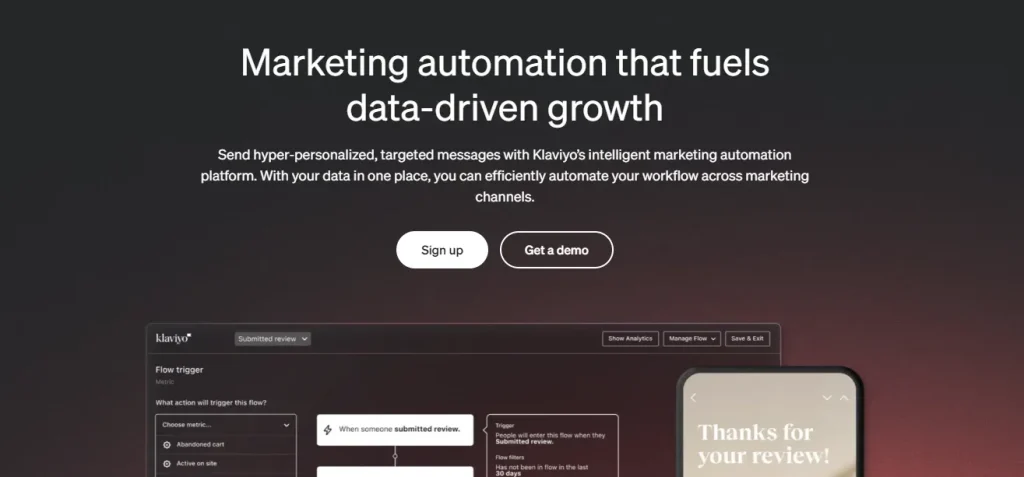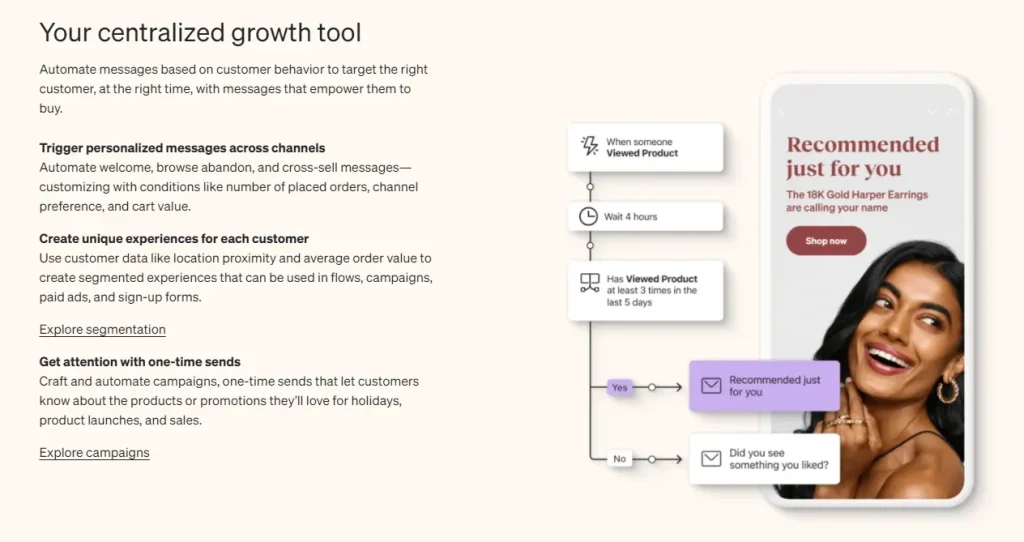
When done correctly, email marketing can significantly boost sales, enhance customer engagement, and drive long-term growth.
One platform that stands out in this domain is Klaviyo, known for its sophisticated and highly effective automated email flow system.
Klaviyo’s automated email flow system (known as ‘Flow’) allows ecommerce businesses to create targeted, personalized email campaigns that run on autopilot, ensuring continuous engagement with customers without the need for constant oversight.
This “set it and forget it” approach frees up valuable time for business owners while still driving impressive results.
In fact, many users have reported achieving an astounding return on investment (ROI) with minimal effort once their email flows are set up.
Overview of the Automated Email Flow System
Here’s a closer look at why Klaviyo’s email flows are essential for ecommerce success.
Types of Email Flows
Klaviyo offers a variety of automated email flows tailored to different stages of the customer journey. These include:
- Welcome Series: Introduce new subscribers to your brand and set the tone for future communications.
- Abandoned Cart Reminders: Remind customers who have left items in their cart to complete their purchase.
- Post-Purchase Follow-Ups: Engage customers after a purchase with thank you emails, product recommendations, and requests for reviews.
- Win-Back Campaigns: Re-engage customers who haven’t interacted with your brand in a while.
These flows are designed to nurture leads, convert prospects, and retain existing customers, ensuring a holistic approach to customer engagement.

Step-by-Step Guide on Setting Up Email Flows and Sign-Up Forms
Setting up effective email flows and sign-up forms in Klaviyo is essential for maximizing the impact of your email marketing efforts. Here’s a detailed guide to help you get started.
To-do 1: Create Sign-Up Forms
Sign-up forms are the first step in building your email list. They must be designed to attract attention and encourage visitors to subscribe.
Design Considerations:
- Mobile-Friendly Design: Since the majority of customers use mobile devices, ensure your forms are responsive and easy to fill out on smaller screens.
- Compelling Call to Action (CTA): Use clear and compelling language in your CTA to encourage visitors to subscribe. For example, “Join Our VIP List for Exclusive Offers” is more enticing than “Sign Up for Our Newsletter.”
- Minimal Fields: Ask for only essential information (e.g., email address, first name) to minimize friction and increase form completion rates.
Implementation:
- Pop-Ups: Pop-up forms can be highly effective but should be used strategically to avoid annoying visitors. Set them to appear after a visitor has spent a certain amount of time on your site or when they show exit intent.
- Embedded Forms: Place these forms in high-traffic areas of your website, such as the footer, blog posts, or product pages.
A/B Testing:
- Test different designs, copy, and timing to see what works best for your audience. Regularly optimize based on performance data.
To-do 2: Set Up Automated Email Flows under ‘Flow’
Automated email flows are the backbone of an effective email marketing strategy. Here’s how to set them up in Klaviyo:
Welcome Series:
- Purpose: Introduce new subscribers to your brand, set expectations, and encourage initial engagement.
- Setup: Create a series of 3-5 emails sent over the first few days or weeks after subscription. Include a welcome message, an introduction to your brand’s story, and a special offer to encourage the first purchase.
Abandoned Cart Reminders:
- Purpose: Recover potential lost sales by reminding customers about the items left in their cart.
- Setup: Create a series of 2-3 emails. The first email should be sent within a few hours of cart abandonment, with follow-ups over the next few days. Include images of the abandoned items, a clear CTA, and possibly an incentive like a discount.
Post-Purchase Follow-Ups:
- Purpose: Engage customers after a purchase to build loyalty and encourage repeat business.
- Setup: Create a series of emails including a thank-you message, product recommendations, and a request for a review. Timing is crucial – send the first email immediately after purchase and space subsequent emails over the following weeks.
Win-Back Campaigns:
- Purpose: Re-engage inactive customers and encourage them to return to your store.
- Setup: Create a series of emails triggered after a set period of inactivity (e.g., 90 days). Offer a special discount or highlight new products to entice them back.
Customer Retention Strategies
Retaining customers is often more cost-effective than acquiring new ones. Email marketing excels at keeping your brand top-of-mind and encouraging repeat purchases.
- Effective Pop-Ups: Use pop-ups to capture email addresses from site visitors. Offer incentives such as discounts or free shipping to encourage sign-ups. Ensure these pop-ups are timed and designed well to avoid annoying potential customers.
- Engaging Email Flows: Create email flows that nurture relationships with your customers. Examples include:
- Welcome Series: Welcome new subscribers and provide them with valuable information and offers.
- Post-Purchase Follow-Ups: Thank customers for their purchase, suggest related products, and request reviews.
- Re-Engagement Campaigns: Send emails to customers who haven’t purchased in a while, offering special deals to win them back.
Revenue-Boosting Tactics
To further maximize revenue, consider implementing these additional tactics:
- Personalized Recommendations: Use data from previous purchases to recommend products that are relevant to each customer. Personalization can significantly increase conversion rates.
- Exclusive Offers and Early Access: Reward loyal customers with exclusive discounts, early access to new products, or special promotions. This not only encourages repeat purchases but also fosters a sense of exclusivity and loyalty.
- Seasonal and Holiday Campaigns: Plan email campaigns around key shopping periods such as Black Friday, Cyber Monday, and Christmas. Offer special promotions and create a sense of urgency to drive sales during these peak times.

Continuous Improvement and Optimization
Maximizing the effectiveness of your email marketing campaigns requires continuous improvement and optimization. By regularly updating your content, conducting A/B tests, and leveraging dynamic content, you can ensure that your email marketing efforts remain relevant and impactful.
Dynamic Content
Keeping your email content fresh and engaging is crucial for maintaining high conversion rates. Here’s how to incorporate dynamic content into your email marketing strategy:
Personalization: Use dynamic fields to personalize emails based on customer data. This can include using the customer’s name, recommending products based on past purchases, or tailoring content to their preferences.
Triggered Emails: Set up automated emails that are triggered by specific customer actions, such as browsing certain products, making a purchase, or abandoning a cart. These emails are timely and relevant, increasing the likelihood of engagement.
Seasonal Updates: Regularly update your email templates to reflect seasonal themes, upcoming holidays, or special events. This keeps your emails visually appealing and timely.
A/B Testing
A/B testing, or split testing, is an essential practice for optimizing your email marketing campaigns. By testing different elements of your emails, you can identify what works best and make data-driven decisions.
Subject Lines: Test different subject lines to see which ones result in higher open rates. Consider testing variations in length, personalization, and urgency.
Email Content: Experiment with different email content, including copy, images, and CTAs. Test different approaches to see what resonates most with your audience.
Send Times: Try sending emails at different times of the day or on different days of the week to determine when your audience is most responsive.
Layouts and Designs: Test various email layouts and designs to find out which ones are most effective at driving engagement and conversions.
Analyzing Results
To ensure continuous improvement, it’s important to regularly analyze the results of your email campaigns and make adjustments based on your findings.
Key Metrics: Monitor key metrics such as open rates, click-through rates, conversion rates, and unsubscribe rates. These metrics provide insights into how your emails are performing and where there may be room for improvement.
Customer Feedback: Pay attention to feedback from your customers. This can include direct feedback from surveys or reviews, as well as indirect feedback from engagement metrics.
Benchmarking: Compare your performance metrics against industry benchmarks to understand how your campaigns are performing relative to others in your sector.
Key Benefits Recap:
Exceptional ROI: Klaviyo’s automated email flows can deliver an impressive return on investment, as evidenced by examples of businesses achieving up to 800x ROI.
Minimal Effort, Maximum Impact: Once set up, these email flows require little maintenance, allowing you to focus on other critical aspects of your business while your email marketing continues to drive sales.
Effective Customer Retention: With well-crafted email flows like welcome series, abandoned cart reminders, and post-purchase follow-ups, you can nurture relationships with your customers, encouraging repeat purchases and building loyalty.
Continuous Optimization: Dynamic content and A/B testing allow you to keep your emails relevant and engaging, ensuring high conversion rates and ongoing improvement of your marketing strategies.
Insightful Analytics: Klaviyo’s robust reporting tools provide valuable insights into the performance of your email campaigns, helping you make data-driven decisions to further optimize your efforts.
By implementing the strategies outlined in this guide, you can harness the full potential of Klaviyo to enhance your email marketing efforts, boost revenue, and build lasting relationships with your customers.
Now is the perfect time to integrate these automated email flows into your marketing strategy and experience the transformative impact they can have on your ecommerce business.
Soodo
http://soodo.coSoodo | Shopify Website Development